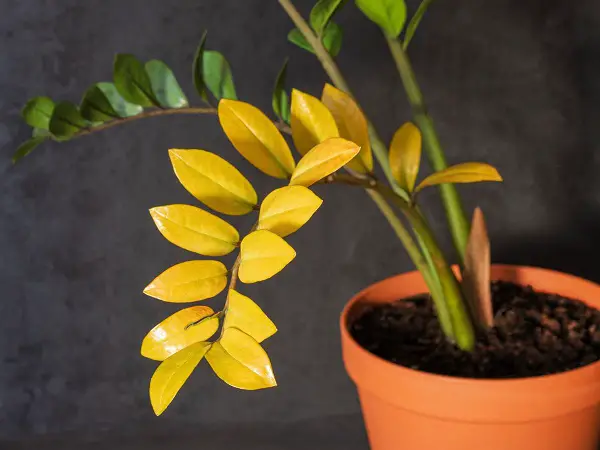I love caring for my indoor plants since that mark a bold statement and complements my decor. ZZ plants are among my favorite houseplants since they stay happy all the time. But this does not imply that they are invincible to common leaf problems.
ZZ plant leaves turning yellow and brown can be worrying at some point. But it is an indicator that something might be wrong with your ZZ plant care routine. I recommend taking the time to investigate your plant and determine the exact cause.
So, will yellow ZZ leaves turn green again? Tweaking the plant care regime will help revive your ZZ plant leaves. I wrote this article to share my experience on how I fix yellow leaves and prevent the issue from occurring again.

10 Causes of ZZ Plant Leaves Turning Yellow
ZZ plant leaves turning yellow is an inevitable phenomenon despite providing ultimate care. But it is something that can be prevented or fixed without requiring expertise. Here are the common causes of yellow leaves on ZZ plants:
Natural Aging Process
Aging leaves on ZZ plants usually turn yellow and brown and then fall. It is part of the plant’s life cycle and happens on the leaves towards the bottom of the stem only. Do not panic if you notice old leaves at the base turning yellow since this normal and inevitable.
I recommend removing the yellow leaves by plucking them or using a sterilized blade. Removing older leaves helps redirect nutrients and energy toward producing new ones. Be sure to prune the old leaves in spring since this is the growing season.
Provide your ZZ plant with proper care to support overall health and vitality. Place the plant in a spot that receives bright indirect sunlight and is less vulnerable to extreme temperature fluctuations. A consistent care routine will help minimize the impact of the natural aging process on the plant.
Overwatering Problem
Overwatering is the leading cause of yellow leaves on ZZ plant. The situation occurs when the roots sit in standing water which prevents access to oxygen and absorption of essential nutrients. Lack of oxygen triggers the development of root rot over time.
Use a pot with proper drainage holes and a well-draining potting mix. It will help get rid of excess water around the roots and prevent your ZZ plant from having yellow leaves. Allow 2-3 inches of topsoil to dry before watering your plant.
Have a strict watering schedule to meet the plant’s needs. Reducing watering frequency in winter and increasing the frequency in summer due to a high evaporation rate. Consult a professional plant expert on how to care for the ZZ plant.
If you notice signs of overwatering, such as yellowing leaves, stop watering and let the soil dry out. Remove any severely affected yellow leaves, but avoid excessive pruning as it can stress the plant further. Adjust your watering habits accordingly to prevent overwatering in the future.
Inconsistent Watering Habits
Underwatering is a minor cause of yellow leaves on ZZ plant. It occurs when the moisture level around the roots is low. Low soil moisture reduces the absorption of nutrients and minerals that foster the development of green leaves.
We recommend testing the soil moisture level before watering the plant. If 2-3 inches of topsoil is dry, water the plant thoroughly until the excess drain out. You can use a moisture meter or physically check the soil moisture with your finger.
Always water your ZZ plant when 2-3 inches of topsoil feels dry. Adjust the watering frequency depending on environmental conditions to maintain adequate moisture level. Be sure to avoid overwatering since it can result in root rot.
Correct Lighting Issue
ZZ plants thrive in bright indirect sunlight to develop a dark-green lush appearance. But insufficient light exposure could make your ZZ plant leaves turn yellow. This is common when the plant is placed in a dimly lit room or far from natural sunlight.
Low lighting condition reduces chlorophyll production which leads to yellowing leaves and leggy stems or distorted growth. We recommend relocating your plant to a spot with bright indirect sunlight or using artificial grow lights.
Avoid direct sunlight exposure since ZZ plant leaves will turn brown.
Direct sunlight scorches the leaves due to the high transpiration and evaporation rate. Ensure your windows have curtains to reduce sunlight intensity reaching your houseplant.If you notice yellowing leaves due to insufficient light, prune the affected leaves and provide proper lighting conditions as soon as possible. With improved light exposure, new leaves should develop a healthy green color.
Lack of Humidity
ZZ plant leaves turning yellow could be due to a lack of humidity. ZZ plants are native to the tropical forest and thrive in high-humidity environments. When exposed to dry air, the plant may struggle to retain moisture causing yellowing leaves.
We recommend grouping houseplants to create a microclimate with higher humidity. You can also install an electric humidifier to help increase moisture in the air. Misting leaves is also another option to consider when looking to increase humidity around plants.
Be sure to mist clean leaves since diry ones will result in pest infestation and diseases. Besides that, place your plant in a well-ventilated room when humidity is high to inhibit fungal diseases. Maintain a consistent watering routine to ensure the ZZ plant receives adequate moisture.
Extreme Temperature
ZZ plants prefer an average room temperature between 65-75°F (18-24°C) to thrive. Any exposure to extreme temperatures can cause yellow and brown leaves. Extreme temperatures make the ZZ plant to express stress and leaf discoloration.
We recommend keeping your favorite houseplant away from drafty windows, doors, and heating and cooling vents to avoid yellow leaf problems. Maintain a consistent temperature in the environment where the ZZ plant is located.
If you notice yellowing leaves due to extreme temperature exposure, move the ZZ plant to a more suitable location with stable temperatures. Trim any severely affected yellow leaves, and provide proper care, including appropriate lighting, watering, and humidity levels.
Nutritional Deficiencies
Yellow leaves on ZZ plant can also be a sign of nutritional deficiencies. ZZ plants require nitrogen, iron, and magnesium nutrients to produce chlorophyll that fosters a lush appearance. Lack of these essential nutrients will lead to yellowing of leaves.
Feed your houseplant with a balanced liquid fertilizer to combat the yellow leaf problems. We recommend feeding your plant twice a month during the growing season (spring and summer). You can use organic fertilizers to avoid issues related to over-fertilization.
If yellowing leaves persist despite proper fertilization, consider getting a soil test to identify specific nutrient deficiencies. This can help determine the appropriate supplements or amendments to address the ZZ plant’s nutritional needs.
Root Bound Problem
ZZ plants are fast-growing and susceptible to root boud problems. Roots becoming tightly packed will limit the ability to absorb water and nutrients effectively. The issue will result in yellow and brown leaves over time.
Transplant your ZZ plant to another container that is slightly bigger. Gently remove the plant from its current pot and carefully loosen the root ball. Choose a new pot that is one size larger and has drainage holes.
Be sure to use fresh potting mix and cover the root ball to secure the plant. The container should also have drainage holes to eliminate excess water after watering. Monitor root-bound signs more often to minimize the risk of yellowing leaves due to restricted root activity.
Pests and Diseases
ZZ plant leaves turning yellow could be due to pests and diseases. Spider mites, mealybugs, and scales feed on the leaf sap leading to yellow leaves. Frequent piercing with venom may also damage the leaf tissues and kill the plant in the long run.
We recommend inspecting the plant for signs of pests while watering. If you notice webbing, tiny moving specks, or sticky residue on the leaves, isolate the plant from others. Use insecticidal soap or neem oil to get rid of pests.
Place your ZZ plant in a well-ventilated room to avoid fungal diseases that can also cause yellowing or browning of leaves. Use a fungicide to treat the disease and isolate your plant from other houseplant. Be sure to avoid overwatering since it also creates a favorable environment for fungal growth.
Acclimation
ZZ plants undergo acclimation when brought into a new environment. The sudden changes in the growing condition could be the reason behind the yellowing of leaves. The issue stresses the plant leading to leaf discoloration.
The plant may shed yellow leaves during acclimation. It is a natural response since the plant has to adjust to its new surroundings. Provide it with consistent care and maintain stable environmental conditions.
Monitor the ZZ plant closely during acclimation and adjust its care as needed. Ensure proper watering, appropriate light exposure, and adequate humidity levels to support the plant’s transition and minimize yellowing leaves.
Final Thoughts from Experts
If you notice your ZZ plant leaves turning yellow and brown, take the time to investigate the plant to identify the exact cause. Identification of the precise cause will help take the appropriate action and fix it.
We hope the information shared in this article will help you revive the yellowing leaves on your ZZ plant. Feel free to share your experience dealing with yellow leaves on ZZ plants in the comment section. (Source: UNIVERSITY OF CONNECTICUT)
People Who Read This Also Read:







